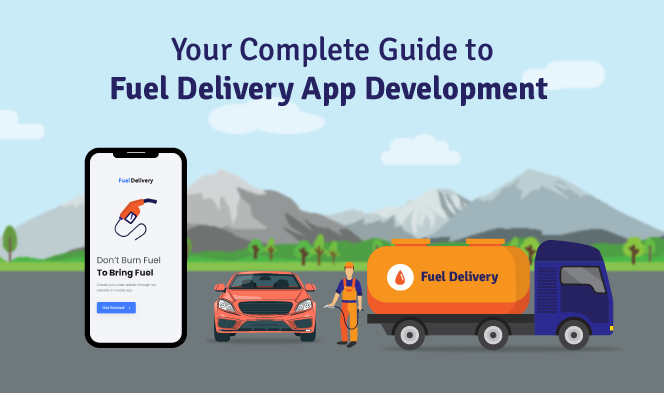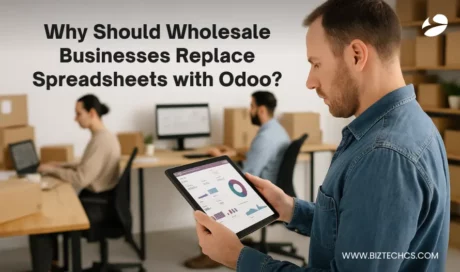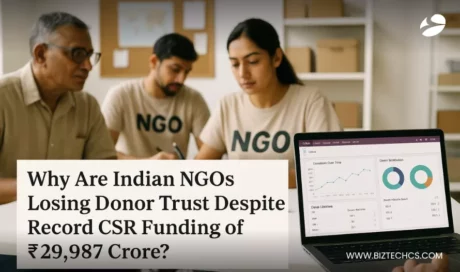4568
Your Complete Guide to Fuel Delivery App Development
28 Dec, 2021
12 min read
4568
28 Dec, 2021
12 min read

Ever been stuck in long queues at petrol pumps or ran out of fuel in the middle of the journey? On-demand fuel delivery is the solution. In today’s time, everything is going on-demand, from grocery, electronics, accessories, clothes, home appliances, etc., to fuel delivery. Customers love the ease of getting everything from the comfort of their location with just a few clicks. This gave rise to many businesses going online, and one of them is the fuel delivery business.
Today, many fuel delivery startups are trying to make their mark and provide customers great service in the emerging market. If you, too, are thinking about how to start your own fuel delivery business, you are at the right place! Here, I will walk you through how to develop an on-demand fuel-delivery app.
Here, I will walk you through ways to develop an on-demand fuel-delivery app. You can learn more about the challenges of fuel delivery app development, cost, required features, and more through this illustrative guide.
Furthermore, you can hire iOS developers to get assistance in this pursuit and build powerful fuel delivery apps.
Getting your food, groceries, electronics, etc., delivered at your doorstep is not a new concept; we are all very familiar with it. Moreover, purchasing things online and getting them delivered to your doorstep with just a few clicks is something we all love.
Fuel delivery is just the same. Except it delivers your fuel at your current location, the delivery person refuels your vehicles, and you are all good to go. The online fuel delivery business is currently the most buzzing as it helps customers if they are stranded somewhere remote.
This is the common question most people ask as it’s an emerging business. Customers will have your fuel-delivery application; they will place an order for fuel from the app when they run out of it or pre-schedule it. Your verified vendors will be notified of the same, and the fuel-delivery truck will navigate via the app to the users’ location.
Delivering fuel at users’ locations when they rush to reach their destination saves them plenty of time as they don’t need to stand in long queues in petrol stations. Moreover, it also ensures users can drive worry-free and won’t get stuck.
Before starting any business, we all want to see the pros and cons and how it will help your customers. Let’s dive deep into the merits and demerits of on-demand fuel delivery app development and how it will provide convenience to your customers:
One of the major challenges of starting a fuel delivery business is safety issues. When fleets carry fuel and are on the roads, there are chances of spilling. So, as a company, you will need to make sure to hire professional drivers, regularly check the safety of your fleet, and make sure there are no leaks.
The online fuel delivery business is still emerging, and different countries have different rules and regulations to deliver fuel. Hence, while starting a business, you will need to research the rules and regulations for your country and state.
Next up, let’s see the benefits.
Customers don’t need to stand in long queues at the petrol pumps; especially on the days when they are in a hurry. They can simply place an order from the app and have it delivered to their location. Moreover, they can also pre-order fuel, which makes it a lot easier for them.
Are your customers’ vehicles out of fuel in the middle of the road and do not have petrol pumps nearby? Your business can handle such emergencies and provide customers with the best quality fuel. Don’t worry, they can easily order fuel from your app. Reaching there timely helps you provide your customers with great customer service.
Customers can pre-order fuel from the app instead of going through the hassle at the last minute. For example: if customers know they are likely to have a long journey the next day, they can check the remaining fuel in the vehicle and pre-order the previous night.
Want to see the MVP of an on-demand fuel delivery app? Reach out to us.
Let’s see the complete step-by-step guide on how to start a fuel delivery business along with app development:
Research and preparing a fuel delivery business plan is one of the most important things, as it helps you have a brief idea about where your application will go. You need to invest heavily in research and understand your market and users.
Once you have carried out in-depth research, your next step is to develop a roadmap for your product. You need to figure out the target audience, features, etc., which will help you streamline the development process and have a basic idea of what problem you are trying to solve.
After researching and defining a fuel delivery business plan, the next major part is defining the target audience to help you understand your users’ persona and who will be using your product. Having a complete understanding of your target audience helps you to define features that fulfill their needs. For example: in the fuel delivery app business, your target audience will be almost everyone who goes to a petrol station for refueling and people of every age. Having in-depth knowledge base software of the user base will make your development process easy and provide you with a perfect solution.
Designs say a lot about your product and company. Moreover, good design helps you to retain customers. Companies have started understanding the importance of investing in UX and designing human-centered applications. Good design makes it easier for customers to walk through your app or website and learn quickly. This helps you to have customers on your application for a long time.
Moreover, the color palette also has a huge impact on gaining your customers’ attention. Remember to use colors that reflect your company culture or the way your users remember and spot your application. Another thing you need to consider is design features to make it easy for users to carry out each task and navigate your application. These two things will help you to develop better designs and provide a great user experience.

For choosing the right technology stack, you will need to decide whether you are planning to go with native app development or hybrid app development. Depending on this, you choose the technology stack. Mostly, we recommend our users choose hybrid app development as it has many advantages over native development.
We have an experienced team of developers who will select a tech stack that matches your application needs. Reach out to us, and our technical experts will guide you.
Customer Panel:

Vendor Panel:

Driver Panel:

Admin Panel:

Curious about how your fuel delivery app will be, with all the features curated just for your users? Reach out to us to have a personalized demo and know how your on-demand fuel delivery application will be. Moreover, know how our experts can help you with fuel delivery app development and define features exclusive to your customers.
Your work is not completed just with fuel delivery app development. Once the application is developed, the second phase is marketing it. There are multiple ways to market your product and reach a wider audience. But first, you will need to prepare your marketing strategies based on your business model and user persona.
Social media marketing and digital marketing are strategies that businesses use today to reach out to more customers. If you plan to increase your reach in a short time on various search engines, you should probably go with Pay Per Click (PPC) marketing. And if you want organic traffic on your website, you should choose to have Search Engines Optimization (SEO).
Additionally, our expert marketers can also help you with App Store Optimization (ASO) techniques, making it easy for you to connect and increase your reach in the App Store. Let us help you define your marketing strategy and work together to help you increase your reach via a search engine, target the right audience, and increase your sales.
Herein, let’s see some of the leading fuel delivery startups and established companies:

Gaston is a European company providing services mainly in Paris. No matter where you are, just one click and Gaston will reach your location, refuel your vehicle, provide five checkpoints cleanups, and clean your car. Leaving it spick and span in no time.
They are a California-based start-up company that delivers fuel to universities, real-estate owners, and campus-based companies. They are said to have more than 300 clients like Facebook, PepsiCo, eBay, Cisco, etc., to whom they provide their services and are currently one of the industry’s leading names.
A Bangalore-based company has a huge client base like OYO rooms, Treebo, LemonTree, etc. They are the first India-based company to bring the revolution of fuel-delivery in the country. They have already delivered more than 3 million liters of fuel and have more than 2000 B2B customers.
Filld is an America-based company that offers commercial services in Seattle, Portland, Bay Area, as well as Vancouver, with BMW, Sixt, and Daimler car2go. They provide their services overnight by messaging their customers twice a week. Customers can reply to their message with yes or no, and if they want it, they need to keep their gas flags open, and the delivery man will refuel their vehicle.
Cafu is the first on-demand diesel delivery service. They started with an aim to make the fueling process simple, safe, and easy to use and decrease unnecessary fuel spills.
Yoshi provides complete car cleaning, oil changing, and refueling services. They ask their customers to provide them with a 4-hour window to provide good quality services. Moreover, as a part of their marketing strategy, they provide their customers with the first 30 days of free service.
This is one of most people’s major questions; here’s a quick estimated breakdown for fuel delivery app development.
| User/Customer Side Features | Admin/API(in Hrs) | Native: Android/IOS (in Hrs) | ||||
|---|---|---|---|---|---|---|
| Module Name | Development | Design | QA/UAT/PM | Development | Design | QA/UAT/PM |
| Business Analysis & Communication | 30 | 10 | 30 | 30 | 10 | 30 |
| Base Code & Architecture | 10 | 1 | 1 | 6 | 1 | 1 |
| Registrations(Customer/Vendor/Driver/Admin) | 30 | 1 | 6 | 50 | 8 | 11.6 |
| Sign In(Customer/Vendor/Driver/Admin) | 40 | 0.5 | 7 | 50 | 12 | 12.4 |
| Profile creation(Customer/Vendor/Driver/Admin) | 22 | 0.5 | 4.5 | 60 | 8 | 13.6 |
| Set Timings/Status | 10 | 0 | 2 | 18 | 3 | 4.2 |
| Sliding Menu(Customer/Vendor/Driver) | 0 | 0 | 0 | 16 | 4 | 4 |
| Dashboard(Customer/Vendor/Driver) | 30 | 0 | 6 | 50 | 6 | 11.2 |
| Set Items | 90 | 0 | 18 | 100 | 20 | 24 |
| Set Pricing | 20 | 0 | 4 | 30 | 5 | 7 |
| Customer Items(List/Details) | 25 | 0 | 5 | 40 | 8 | 9.6 |
| Search functionality | 8 | 0 | 2 | 15 | 1 | 3.2 |
| Order placing flow | 30 | 0 | 6 | 50 | 8 | 11.6 |
| Payments | 16 | 0 | 3 | 25 | 1.5 | 5.3 |
| Orders history(Customer/Vendor/Driver) | 40 | 0 | 8 | 70 | 12 | 16.4 |
| Rate & Feedback | 30 | 0 | 6 | 45 | 8 | 10.6 |
| Notifications Logic(Push, Email, InApp) | 60 | 0 | 12 | 70 | 4 | 14.8 |
| Graphics Design Integration | 0 | 10 | 0 | 0 | 80 | 16 |
| Admin managements | 150 | 25 | 35 | 0 | 0 | 0 |
| Subtotal: | 641 | 48 | 155.5 | 725 | 199.5 | 206.5 |
| Backend: Admin/API | 844.5 | |||||
| Frontend: Android/IOS | 1131 | |||||
| Grand Total: | 1975.5 | |||||
Note: Kindly note that the development can be done in phases. We can discuss further the cost model keeping your requirement in mind. Further, the cost to hire Android app developers and iOS developers vary. So, the final cost will depend on your specific requirements.
The on-demand fuel delivery business is here to stay, and the buzzing field will evolve a lot in the near future. The market has an enormous scope to serve in the coming years and will likely expand its service and usage in almost every industry. Hence, this is the right time to start with the fuel delivery business.
Are you searching for the right fuel delivery app development company that can help with all technicalities? Your search ends here! Biztech will provide you with complete end-to-end custom solutions, answer all your questions on how to start a mobile fuel delivery business, along with services like designing, developing, testing, marketing, etc. We are here to be your long-term technical partner and provide you with complete guidance.
All product and company names are trademarks™, registered® or copyright© trademarks of their respective holders. Use of them does not imply any affiliation with or endorsement by them.

Artificial Intelligence (AI)
98
By Afzal Qureshi
20 Nov, 2025

Odoo
75
By Uttam Jain
19 Nov, 2025

Odoo
123
By Uttam Jain
18 Nov, 2025